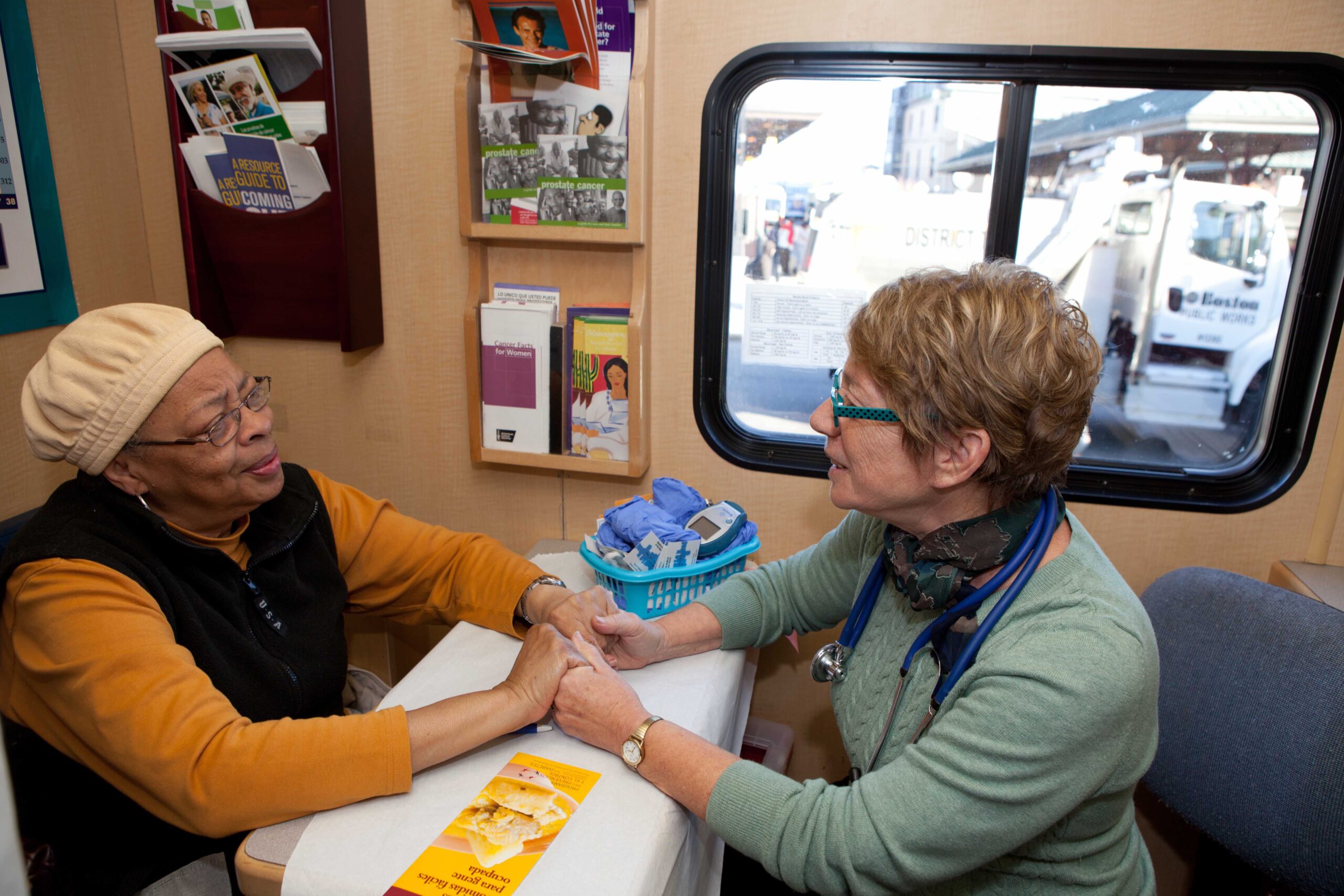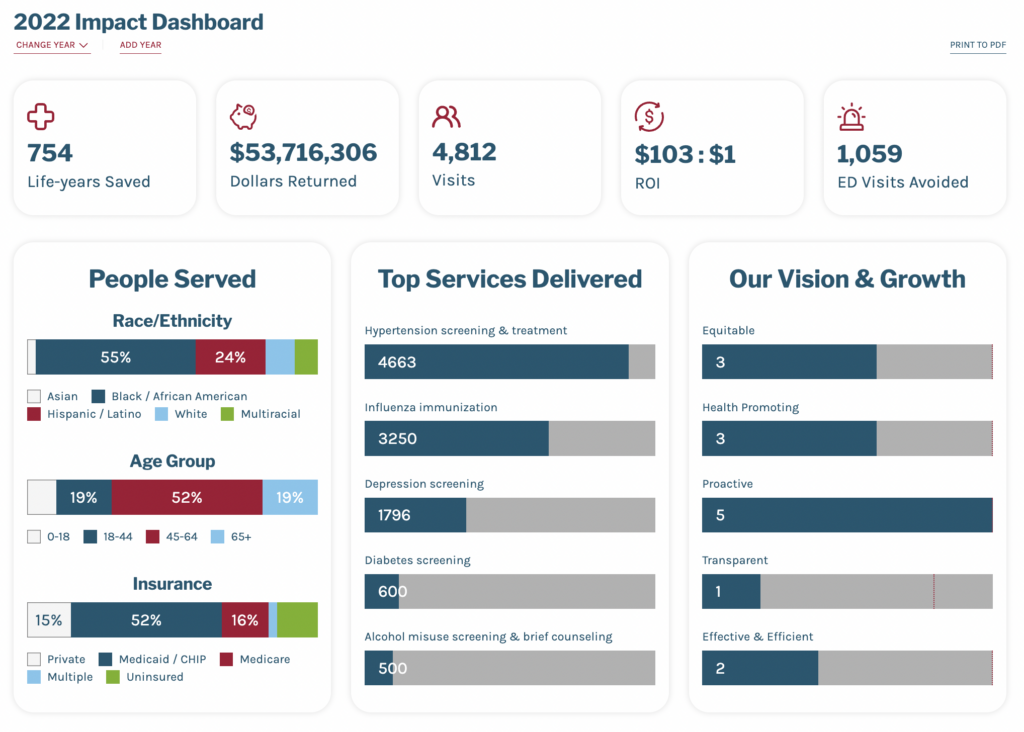On your mobile clinic’s dashboard: Effective and efficient care

by William Zhuo-Ming Li, Harvard Medical School, MD Candidate
On Mobile Health Map, users create their own dashboards – visual displays of their data. The dashboard provides mobile clinics with actionable insights and helps them tell their mobile clinic’s unique story of service and impact. An important part of the dashboard is public health quality. Read more below on how mobile clinics can ensure they are providing quality services by making their program more effective and efficient.
Key Points:
- The US health system struggles to provide quality services at low cost, leading to poor health outcomes and high costs.
- Mobile health clinics are a cost-effective solution in addressing the issue, helping underserved communities access preventive care and manage chronic conditions.
- Five strategies can maximize effectiveness: using evidence-based practices; measuring changes in knowledge, behavior, or health after intervention; measuring differences in the population’s health when compared to another group not served by the program; tracking expenses per individual served; and tracking return on investment.
Mobile clinics are key to improving quality and reducing costs
A major question of the US health system is how to provide high-quality services at low cost. Health care is more costly in the United States than in any other country. Almost half of all Americans say they have difficulty paying for medical care, and even higher among people who are low income, uninsured, and Black or Hispanic. This has negatively affected health outcomes; we fall behind other high-income countries in many key areas, such as life expectancy, preventable injuries and death, suicides, and birth complications. COVID-19 made it even harder for our system to be effective and efficient over the past few years. During the pandemic, health disparities have widened, death rates have increased, and costs have risen.
Mobile health clinics are an effective way to improve health outcomes and reduce health care costs. Studies show that mobile clinics are more efficient at helping underserved communities access preventive care, manage chronic disease, and pursue healthier living. One report found that services provided by The Family Van in Boston prevented early disability and death from disease as well as avoidable emergency visits. This means more dollars saved for the health system and society at large. Mobile clinics can also easily adapt to meet the changing needs of the communities they serve. For example, many have provided testing or vaccines to patients in response to COVID-19. Mobile clinics thus play an important role in the movement toward value-based care by delivering a range of services to benefit more patients at a cheaper price.
What can our mobile clinic do to maximize effectiveness and efficiency?
An initial challenge for many mobile clinics is figuring out how to improve health quality and save costs at the same time. Below are five ways that can maximize your program’s effectiveness and efficiency.
- Use evidence-based practices. This means using the best available research and data to create programs that benefit patients the most. The National Institutes of Health has a list of evidence-based public health recommendations, and more online resources can be found on Mobile Health Map, Rural Health Information Hub, and The Community Guide.
- Measure changes in knowledge, behavior, or health after intervention. Patient surveys, knowledge checks, and lab measurements are useful sources of data for identifying a community’s health needs. You can compare data from patients before and after using your program to track its impact on their health.
- Measure differences in a group’s health when compared to another group that hasn’t received your program. Another method to evaluate your program’s impact is to compare health outcomes of people who’ve used your services to those with similar demographics who haven’t.
- Track expenses per individual served. This is an important way to measure budget impact and answer the questions: Where do the dollars go? What are the areas of most waste? How can unnecessary costs be reduced?
- Track return on investment. You can calculate return using savings from prevented emergency room visits plus the value of quality adjusted life years saved (QALYs) as a result of your services. This is highly effective in showing the number of dollars saved to the health system and society for every dollar spent on your program.
Evaluate the quality of your mobile public health program
Mobile health clinics are an effective solution to the struggles of the US healthcare system. Using evidence-based practices while measuring changes in knowledge, behavior, and health outcomes can help draw a clearer picture of how effective a clinic really is. Tracking expenses per individual served and ROI are also important to evaluating your work. However, it’s not enough to just monitor progress – the next step is taking action based on those analytics.

Create a dashboard for your clinic and track your results. By doing so you will be able to see what works and customize your program accordingly. Careful planning through analysis and data-driven decisions will lead to healthier communities overall. Together we can make a difference!
William Zhuo-Ming Li is a student at Harvard Medical School. He is passionate about pediatrics and community-engaged healthcare. He also loves to cook, cat-sit, longboard, and play board games.

